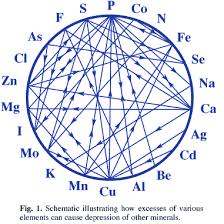Hair Analysis
 There are many ways to assess nutritional status and we prefer measuring tissue mineral levels in the hair. Nutritional physiology takes place at the cellular level, not within the blood or at any other location. Tissue mineral analysis is unique in that it inexpensively provides information directly about cellular activity – the main site of nutritional metabolism. Therefore, we can assess and diagnose clinical and subclinical disease states and patterns.
There are many ways to assess nutritional status and we prefer measuring tissue mineral levels in the hair. Nutritional physiology takes place at the cellular level, not within the blood or at any other location. Tissue mineral analysis is unique in that it inexpensively provides information directly about cellular activity – the main site of nutritional metabolism. Therefore, we can assess and diagnose clinical and subclinical disease states and patterns.
Because of its mathematical nature, hair mineral analysis offers a way to determine supplement dosage and proportions of foods with greater accuracy.
Levels and ratios of tissue minerals relate to the activity of specific organs and glands. By calculating ratios on a tissue mineral test, the function of major glands and organs can be assessed, often long before abnormalities appear on blood tests.
Conditions which may result or be aggravated by a mineral imbalance are: Hormone imbalances, cysts/fibroids, endometriosis, fertility issues, menstrual irregularities, allergies, anemia, arthritis, cardiovascular disease, depression, diabetes, gastrointestinal and digestive issues, emotional problems, hair loss, headaches, hyperactivity, hypertension, hypoglycemia, musculo-skeletal disorders, prostate disorders, skin rashes, thyroid conditions, auto-immune diseases, etc.
Mineral imbalances may be caused by the following:
- Improper diet – such as excessive intake of processed foods, refined carbohydrates (wheat, corn, soy) and sugars, vegetarian diets or other exclusive diets.
- Taking vitamins and minerals that are synthetic/pharmaceutical and are not bio-available to your body; they may be "all natural' but not absorbable.
- Medications and birth control pills.
- Toxic accumulation of heavy metals from the environment, job, hobby or food preparation methods.
- Inheritance of mineral patterns from parents.
We choose to use Analytical Research Laboratories for our Hair Analysis testing as they are the industry leader in this field and they are only one of two labs across the country who do not wash the hair sample prior to testing. Washing hair samples at the laboratory has been shown to erratically wash out the water-soluble elements, which creates much less accurate results. In a 2001 study in the Journal of the AMA (Seidel, S. et al., Assessment of Commercial Laboratories Performing Hair Mineral Analysis, JAMA, 285(1) Jan 3:67-72.) the two laboratories that did not wash the hair (ARL being one of them), showed superb reliability. ARL offers the only complete individualized test interpretation by the method developed by the late Dr. Paul C. Eck, their founder. This 15-20 page report is very unique as it includes information related to one's metabolic rate, energy levels, sugar and carbohydrate tolerance, immune system, autonomic balance, glandular activity, and metabolic trends.
The cost of the initial Hair Tissue Mineral Analysis test is only $81 and each re-test will only cost $49 or $78 depending on which re-test option is chosen. The cost of test is paid directly to the lab (Analytical Research Labs) and is not billable to insurance. You can find out more information by visiting www.arltma.com.
Preparing Your Hair for Sampling
If you do any hair processing treatments (such as bleaching, coloring, or perming), then the hair should not be tested until is has been 4 weeks since your last treatment and the hair must be washed at least 10 times as well.
- The hair should be washed at least 4 hours, but no more than 24 hours prior to your scheduled appointment.
- The hair must be completely dry.
- Do not use any leave-in hair product (such as hair creams, gels and oils). Hair spray is acceptable.
Additional Information:
There are several cautions and concerns regarding hair products. Most shampoos, rinses and conditioners do not contain metals and will not effect the accuracy of the analysis. However, medicated shampoos of concern are Selsun Blue (selenium) and Head and Shoulders (zinc). Grecian Formula contains lead and iron.
We will be cutting the hair from the back of the head, at the nape of the neck (roughly at the level of the middle ear). We will be cutting the hair sample as close to the scalp as possible and will be using the inch of hair closest to the scalp for the sample. The distal end of the hair longer than 1 inch will be discarded.
The lab does recommend that we use head hair only due to it's consistent rate of growth; however, pubic and other body hair can be used if sufficient head hair is not available. Special at-home instructions will be provided from our team if a body hair sample is needed instead.
If you have questions about how to properly prepare your hair for your appointment, please do not hesitate to call us at 618-692-1800.
